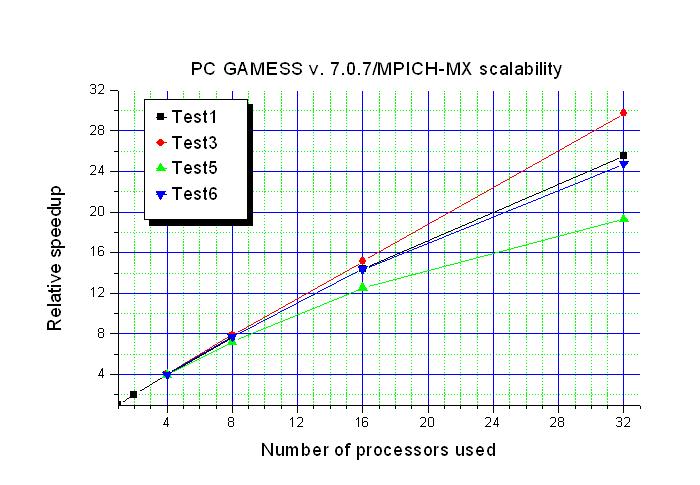Graphical representation of scalability

|
Number of processors used |
Test 1, Wall clock time and relative speedup |
Test 3, Wall clock time and relative speedup |
Test 5, Wall clock time and relative speedup |
Test 6, Wall clock time and relative speedup |
|
1 |
4990.2 1.00 |
n/a |
n/a |
n/a |
|
2 |
2485.0 2.01 |
n/a |
n/a |
n/a |
|
4 |
1263.7 3.95 |
2337.7 4.00 |
2759.8 4.00 |
7039.0 4.00 |
|
8 |
651.3 7.66 |
1182.6 7.91 |
1527.6 7.23 |
3649.3 7.72 |
|
16 |
346.3 14.41 |
618.3 15.12 |
880.2 12.54 |
1960.3 14.36 |
|
32 |
195.3 25.55 |
314.9 29.69 |
572.6 19.28 |
1138.4 24.73 |

Myricom's private Opteron cluster, dual processor (single core) AMD Opteron 248, 2.2 GHz, TYAN S2891 baseboard with nVidia nForce Professional 2200 chipset, 4 GB DDR 333 RAM, 16 nodes, interconnect: Myri-10G network card with CX4 port (10G-PCIE-8A-C), Myri-10G switch, MX-10G version 1.2.0i (Myrinet Express), MPICH-MX 1.2.7.4 using MX_RCACHE=1 flag, Linux 2.6.17.11 (Ubuntu)
Test 1, single-point direct DFT (B3LYP) energy plus gradient for medium-size system (623 basis functions). View image
Test 3, single-point direct MP2 energy for medium-size system (623 basis functions, the same system as one used for Test 1). View image
Test 5, single-point direct CASSCF(12,12) for medium-size system (retinal molecule, cc-pVDZ, 565 Cartesian basis functions) using ALDET code. View image
Test 6, single-point direct CIS energy plus gradient of first excited state of medium-size system (porphyrin molecule, cc-pVTZ (aug-cc on Nitrogens), 1130 Cartesian basis functions, D2h group). View image
All tests were run in standard parallel mode using dynamic load balancing over p2p interface, with two processes per each dual-CPU node. Wall clock times are given on master node in seconds. Test 5 is the most communication intensive and would scale better for larger job. For these tests, the most commonly used MPI calls are MPI_Allreduce and MPI_Bcast.
We are grateful to Scott Atchley (Myricom) for providing us by benchmark data on this cluster.
Copyright © 2007 by Alex A. Granovsky
Press to visit PC GAMESS' eight core systems performance comparison page
Press to visit PC GAMESS' Woodcrest vs. Opteron performance comparison page
Press to visit PC GAMESS Pentium 4 family Xeon processor benchmarks page to compare the results of these benchmarks with those obtained on Xeon DP processors.
Press to visit PC GAMESS Pentium 4 family benchmarks page to compare the results of these benchmarks with those obtained on various Netburst (Pentium 4 and Pentium D) processors.
Press to visit the PC GAMESS vs. WinGamess performance comparison page to compare the results of these benchmarks with those obtained on older processors. Input files can be found there too.